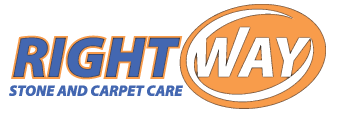Hot Water Extraction (also called Steam Cleaning)
Hot water extraction is sometimes referred to as ‘Steam Cleaning’. Actually this is a misapplied term, because real steam is too dry and hot to clean carpet properly. Hot water extraction is recommended and used by many carpet manufacturers and professional cleaners. In this method, hot cleaning solution is sprayed under pressure deep into the carpet fibers and is immediately extracted with a vacuum source. The tool’s vacuum then sucks all of the dirt, cleaning agent, and other particles into a recovery tank and is usually poured into the sanitary waste system. Because this method removes more contaminants than the other carpet cleaning methods, hot water extraction is favored by the Environmental Protection Agency (EPA) and is the preferred method of the Institute of Inspection, Cleaning and Restoration Certification (IICRC).
Hot water extraction is RightWay’s primary method of cleaning.
Bonnet Cleaning (also called Dry Cleaning)
Although often called a “dry” cleaning method, the bonnet (also known as “absorbent pad”) method of carpet cleaning actually uses more water than the true “dry” methods. The cleaning product (sometimes mixed with carbonated water) is misted onto the carpet in the form of a spray. Next, bonnet cleaning uses a machine that looks somewhat like a buffer for a hardwood or tile floor. The machine has a large rotating pad goes over the carpet in a circular motion and absorbs the soil as it is moved over the carpet. The soil attaches itself to the pad and the pad is changed often, to reduce re-soiling, and is kept lubricated with a detergent solution aimed at reducing the distortion of the pile of your carpet.This method has the advantage of drying very quickly because of the small amount of moisture used. It generally does a good job of cleaning the top 1/3 of the carpet pile that is visible to the eye. But does little to remove the heavier grit and sand that damages carpet over time. Because there is no flushing action or extraction, there is very little deep cleaning. This method may be considered as an interim cleaning between more effective deep cleanings.
-RightWay will use the Bonnet cleaning method upon request.
Dry Cleaning (Dry Foam and Dry Powder)
The term “dry” cleaning as applied to carpet can be misleading. The majority of the cleaning solutions are actually wet, but are allowed to dry with the soil and dirt particles attached. After drying, the cleaner is vacuumed up taking the dirt with it. There are 2 main types of “dry” cleaning: Dry foam and Dry powder.
Dry Foam/Shampoo: A detergent solution is whipped into a foam. The very high foam content is applied to the carpet and worked into the pile. The foam dries with the soil and dirt contained in a non-sticky residue that can then be vacuumed up. This does allow for faster drying times. Although some DRY FOAM machines have a built in vacuum they still rely on the cleaning product drying to a flaky residue that the dirt adheres to and being sucked away by a vacuum cleaner. The dry foam method may not be the best way to clean a deep pile carpet, as the dirt and foam are sometimes pushed down into the pile rather than being sucked into the vacuum. If you have a shag or deep pile carpet, it is recommended that you have them steam cleaned.
Dry Powder: A dry absorbent polymer compound (sometimes an organic compound is used) is worked into the carpet using a special agitating brush machine. The circular brush or cylindrical rotating brush is used to force the dry cleaning product in contact with the soil. After the carpet dries, which is surprising fast, the cleanser is then thoroughly vacuumed to remove all the dirt and detergent in one step. This method has the fastest drying times of all carpet cleaning methods and has the advantage of being able to be walked on almost immediately after cleaning. Be aware that this type of cleaning can leave a residue of the detergent compound in your carpet if not vacuumed properly. W Dry powder cleaning can do a fairly good job of cleaning the top 1/3 of the fiber that is visible if it is not heavily soiled. Again, it does very little to remove the heavier soils in the base of the fibers. It’s weakness is the extraction cycle. If not vacuumed with a powerful commercial vacuum, large amounts of the cleaning product can remain, and over a period of time build up and cause considerable problems later on.
-RightWay does not use these methods.
